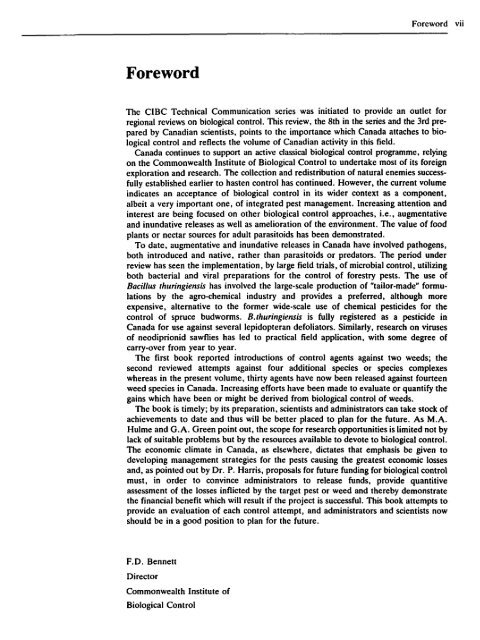pdf, 57.71Mb - Entomological Society of Canada
pdf, 57.71Mb - Entomological Society of Canada
pdf, 57.71Mb - Entomological Society of Canada
Create successful ePaper yourself
Turn your PDF publications into a flip-book with our unique Google optimized e-Paper software.
Foreword<br />
Foreword vii<br />
The CIBC Technical Communication series was initiated to provide an outlet for<br />
regional reviews on biological control. This review, the 8th in the series and the 3rd prepared<br />
by Canadian scientists, points to the importance which <strong>Canada</strong> attaches to biological<br />
control and reflects the volume <strong>of</strong> Canadian activity in this field.<br />
<strong>Canada</strong> continues to support an active classical biological control programme, relying<br />
on the Commonwealth Institute <strong>of</strong> Biological Control to undertake most <strong>of</strong> its foreign<br />
exploration and research. The collection and redistribution <strong>of</strong> natural enemies successfully<br />
established earlier to hasten control has continued. However, the current volume<br />
indicates an acceptance <strong>of</strong> biological control in its wider context as a component,<br />
albeit a very important one, <strong>of</strong> integrated pest management. Increasing attention and<br />
interest are being focused on other biological control approaches, i.e., augmentative<br />
and inundative releases as well as amelioration <strong>of</strong> the environment. The value <strong>of</strong> food<br />
plants or nectar sources for adult parasitoids has been demonstrated.<br />
To date, augmentative and inundative releases in <strong>Canada</strong> have involved pathogens,<br />
both introduced and native, rather than parasitoids or predators. The period under<br />
review has seen the implementation, by large field trials, <strong>of</strong> microbial control, utilizing<br />
both bacterial and viral preparations for the control <strong>of</strong> forestry pests. The use <strong>of</strong><br />
Bacillus thuringiensis has involved the large-scale production <strong>of</strong> "tailor-made" formulations<br />
by the agro-chemical industry and provides a preferred, although more<br />
expensive, alternative to the former wide-scale use <strong>of</strong> chemical pesticides for the<br />
control <strong>of</strong> spruce budworms. B.thuringiensis is fully registered as a pesticide in<br />
<strong>Canada</strong> for use against several lepidopteran defoliators. Similarly, research on viruses<br />
<strong>of</strong> neodiprionid sawflies has led to practical field application, with some degree <strong>of</strong><br />
carry-over from year to year.<br />
The first book reported introductions <strong>of</strong> control agents against two weeds; the<br />
second reviewed attempts against four additional species or species complexes<br />
whereas in the present volume, thirty agents have now been released against fourteen<br />
weed species in <strong>Canada</strong>. Increasing efforts have been made to evaluate or quantify the<br />
gains which have been or might be derived from biological control <strong>of</strong> weeds.<br />
The book is timely; by its preparation, scientists and administrators can take stock <strong>of</strong><br />
achievements to date and thus will be better placed to plan for the future. As M.A.<br />
Hulme and G.A. Green point out, the scope for research opportunities is limited not by<br />
lack <strong>of</strong> suitable problems but by the resources available to devote to biological control.<br />
The economic climate in <strong>Canada</strong>, as elsewhere, dictates that emphasis be given to<br />
developing management strategies for the pests causing the greatest economic losses<br />
and, as pointed out by Dr. P. Harris, proposals for future funding for biological control<br />
must, in order to convince administrators to release funds, provide quantitive<br />
assessment <strong>of</strong> the losses inflicted by the target pest or weed and thereby demonstrate<br />
the financial benefit which will result if the project is successful. This book attempts to<br />
provide an evaluation <strong>of</strong> each control attempt, and administrators and scientists now<br />
should be in a good position to plan for the future.<br />
F.D. Bennett<br />
Director<br />
Commonwealth Institute <strong>of</strong><br />
Biological Control
















